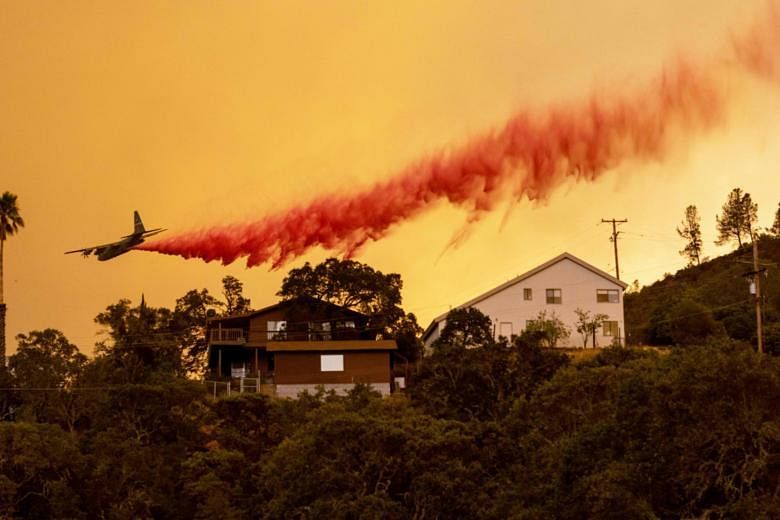LOS ANGELES (BLOOMBERG) - Californians just saved themselves from what would've been the biggest coordinated blackout of all time.
Now, on to the next crisis: Dry lightning and extreme heat that together ignited 155 fires within 24 hours and are setting off more.
On Tuesday (Aug 18) - just as California was preparing to plunge as many as six million people into darkness to save the power system from one of the worst heat waves in generations - blazes torched tens of thousands of acres, forcing people to flee their homes and prompting California Governor Gavin Newsom to declare a state of emergency only days into the peak of the wildfire season.
Add them all to 2020's global tally of extremes - including fires, excruciating heat and tropical storms. They're offering a glimpse into the future of a climate-changed world.
"We've had so many evacuations and so many fires happening, there's no way to keep up honestly," Ms Lynnette Round, a spokesperson for California's fire division, said by telephone late on Tuesday.
"This is rare for a single day, and resources are stretched very thin. People just need to make sure they're ready to go at a moment's notice."
Ms Round attributed the unusual eruption of blazes across the state to bursts of lightening that struck on Monday and into Tuesday, dry weather and gusty winds - perhaps the same winds that ended up saving Californians from unprecedented rolling blackouts on Tuesday night.
At one point, grid manager California Independent System Operator had estimated that six million people could go dark.
Then the weather began cooling, people dialled back their air conditioners and an unexpected burst of wind power generation came online to help save the day.
"Californians made tonight a success," said Mr Steve Berberich, president and chief executive officer of California ISO.
"Everyone pulled together and responded to our warning with action."
Some risk of rotating outages remains. The California ISO has issued a call for energy conservation on Wednesday as temperatures climb toward 39 degrees Celsius in Sacramento and 36.6 degrees in Los Angeles, threatening to strain the power grid once again. But the heat is forecast to begin subsiding by the end of the week.
Since Friday, millions of Californians have seen their lights abruptly cut with little notice - part of a last-ditch effort by the state's grid operator to save the system from heat-induced power failures.
It's the only time outside of the 2000-2001 energy crisis that the agency has initiated rotating outages, and it couldn't have hit at worse time, with the pandemic forcing people into lockdown, leaving them with little choice but to endure the heat indoors.
The cutoffs have been reminiscent of the mass blackouts utilities carried out last year to keep electrical lines from sparking fires during unusually strong windstorms - all extreme weather events made more frequent by climate change.
The grid operator's call to impose rotating blackouts has already drawn harsh criticism from industry experts who say they weren't necessary.
Mr Newsom has ordered an investigation. And despite wind power showing up to save the day, the blackouts have sparked a debate over the reliability of the grid, which has become increasingly dependent on intermittent renewable energy resources.
PERSONAL PLEAS
On Monday, advisers to Mr Newsom had to make personal telephone calls to refineries, other industries and the state's port authorities, pleading for them to reduce power consumption to evade blackouts.
On Twitter, President Donald Trump blamed Democrats for the blackouts, saying they were "intentionally" shutting off power to millions of people.
"In California, Democrats have intentionally implemented rolling blackouts - forcing Americans in the dark," the President said.
"Democrats are unable to keep up with energy demand."
One thing that has made California's grid so vulnerable to soaring demand is the state's rapid shift away from natural gas.
About 9 gigawatts of gas generation, enough to power 6.8 million homes, have been retired over the past five years as the state turns increasingly to renewables, according to BloombergNEF.
That leaves fewer options when the sun sets and solar production wanes.
The state's grid operator said it was able to bring in some power from outside the state on Tuesday, but imports were hard to come by in recent days as the heat blanketed the entire western US.
"California is in a tight spot," BNEF analyst Brian Bartholomew said.
The heat wave gripping the West Coast stems from a stubborn, high-pressure system that has parked itself across the Great Basin spanning Nevada and other western states.
It essentially acts as a lid trapping hot air, and there aren't any indications it's going to budge soon.
Such phenomenons, sometimes called heat domes, are getting worse because the Earth's climate is changing.
As the planet warms, the contrast between the heat at the equator and the cold at the pole decreases.
That saps the strength of the jet stream, which otherwise would be able to shove the ridges out of the way.
It explains in part why extreme heat has smothered regions around the world in recent weeks.
And it does not bode well for California's wildfire season. One blaze, known as the SCU Lighting Complex, has burned through 10,117 hectares east of Silicon Valley and was uncontained as of 5pm local time on Tuesday.
The Apple fire east of Los Angeles scorched more than 13,354ha before firefighters got it under control.
So far, fires have burned 82,555ha and damaged or destroyed 87 structures.
Ms Round, at the California Department of Forestry and Fire Protection, couldn't say exactly how many fires had erupted by Tuesday night.
"It's all happening so quickly," she said. "It's been hard to keep up."

